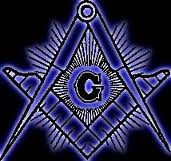
Due to a lack of any verifiable documentation the precise origins of Freemasonry are hotly contested. Currently the most widely held belief is that modern Freemasonry evolved out of Stonemasons guilds in 17th century England. This theory, supported by the United Grand Lodge of England and the premier Masonic research bodies, proposes that these operative guilds began to admit non operative (or speculative) members for the further spread of their moral and spiritual ideals.
There is considerable, though by no means conclusive, evidence to suggest that Masonic lodges more recognizable to the modern Freemason were in existence in Scotland as much as a century earlier and the earliest text claimed to be of Masonic origin, The Regius Manuscript, has been dated as early as 1390 CE.
Founding the first Grand Lodge
The first Grand Lodge, the Grand Lodge of England, was founded on the 24th, June, 1717 when four London lodges met for a joint dinner, proclaiming themselves pre-eminent and assuming regulatory control over Freemasonry in England. This apparently spontaneous formation of the Grand Lodge understandably caused resentment amongst the other existing lodges of the time and ultimately lead to a schism in English Freemasonry that was not fully resolved until 1813 when the two rival groups formed the United Grand Lodge of England – the body which exists and co-ordinates English Freemasonry to this day.
In the mean time, the popularity of Freemasonry was spreading internationally. Grand Lodges were formed in Ireland in 1725 and Scotland in 1736. By the 1730’s Freemasonry had also been exported to the British Colonies in North America and, after the American Revolution, Grand Lodges began to form in each of the American states.
Freemasonry In Canada
1606 The so-called Masonic Stone of 1606 was discovered near the settlement of Port Royal, Nova Scotia, in 1827.
.
1634 First record of a freemason in Canada, then known as New France:
Lord Alexander, Viscount Canada, son of the first Earl of Stirling, Scotland, Master of Work to King Charles I, founded a colony of Scots on the banks of the St. Lawrence River. Lord Alexander was a member of Edinburgh Lodge No. 1 at Mary’s Chapel, which has records dating from 1599 and — tradition maintains — was in existence in 1491.
.
1738 First masonic lodge in Canada is instituted at Annapolis, Nova Scotia.
.
1843 Fort Victoria is established to bolster Britain’s claim to Vancouver’s Island.
.
1854 October 25th. Lieutenant Alexander Dunn is awarded the Victoria Cross for saving the lives of two men during the famous Charge of the Light Brigade at Balaclava. Dunn, a freemason, is the first Canadian to be awarded the Victoria Cross.
.
1858 July 10th. A Victoria newspaper ad calls all interested freemasons to a meeting with the object of forming a masonic lodge in Victoria. The publisher of the paper is Amor de Cosmos, a freemason who would later become the second premier of the province of British Columbia.
.
1859 September 7th. The first masonic funeral in the Colony was held for Samuel Hazeltine, Government Steamboat Inspector, who died from injuries received in a marine accident at Victoria.
.
1860 Victoria Lodge No. 1085, is formally constituted in Victoria, in the colony of Vancouver’s Island. Robert Burnaby, for whom Burnaby, B.C. is named, installs the first officers. Russian born John Malowansky, a Victoria news agent and tobacconist, is the first person to be made a freemason in the colonies.
.
1862 Thomas Harris, a freemason, is elected the first mayor of Victoria.
.
1867 The Dominion of Canada is established on July 1st. Freemason Sir John A. Macdonald becomes Canada’s first Prime Minister.
.
1871 United Colony of British Columbia joins Confederation and becomes the Province of British Columbia.
October 21st. The Most Worshipful Grand Lodge of Ancient Free and Accepted Masons of British Columbia is founded in Victoria, British Columbia. The Grand Lodge is consecrated and dedicated on December 26th, 1871. Israel Wood Powell is the first Grand Master while Robert Burnaby becomes the first Past Grand Master.
November 13th. John Foster McCreight, the first Deputy Grand Master of the Grand Lodge of British Columbia, becomes the first premier of the Province of British Columbia.
Israel Wood Powell, for whom Powell River, B.C. and Powell Street in Vancouver are named, refused the offer to become the first Lieutenant-Governor of British Columbia and becomes the first Superintendent of Indian Affairs.
Freemason John Jessop becomes the first Superintendent of Education.
During the 1890’s a French journalist going by the pseudonym Leo Taxil published a series of pamphlets and books charging Freemasonry with various wild allegations including conspiracy and devil worship. On April 19, 1897, Taxil revealed that the publications had been part of a elaborate series of hoaxes he had conducted. Records say he was mobbed by his audience and had to be removed by police. Despite his revelation Taxil’s works are often the foundation of anti-Masonic claims to this day.
On January 8th, 1934, the German Ministry of the Interior under Adolf Hitler ordered the complete dismantling of Freemasonry, the destruction of Masonic Lodges and the incarceration of convicted Freemasons in concentration camps. Freemasons were forced to wear an inverted Red Triangle to identify themselves as political prisoners. It is estimated that between 80 000 and 200 000 Freemasons were murdered under the Nazi Regime.
After the Second World War, Masonic membership experienced a significant boom as men looked to maintain a sense of belonging and comradeship. Interest in Freemasonry is regularly revived by the works of historians or story tellers, most recently in 2003 returning to public interest when included in the fictional work, The Da Vinci Code, by novelist Dan Brown.
Current membership worldwide is estimated at 6 million.

















